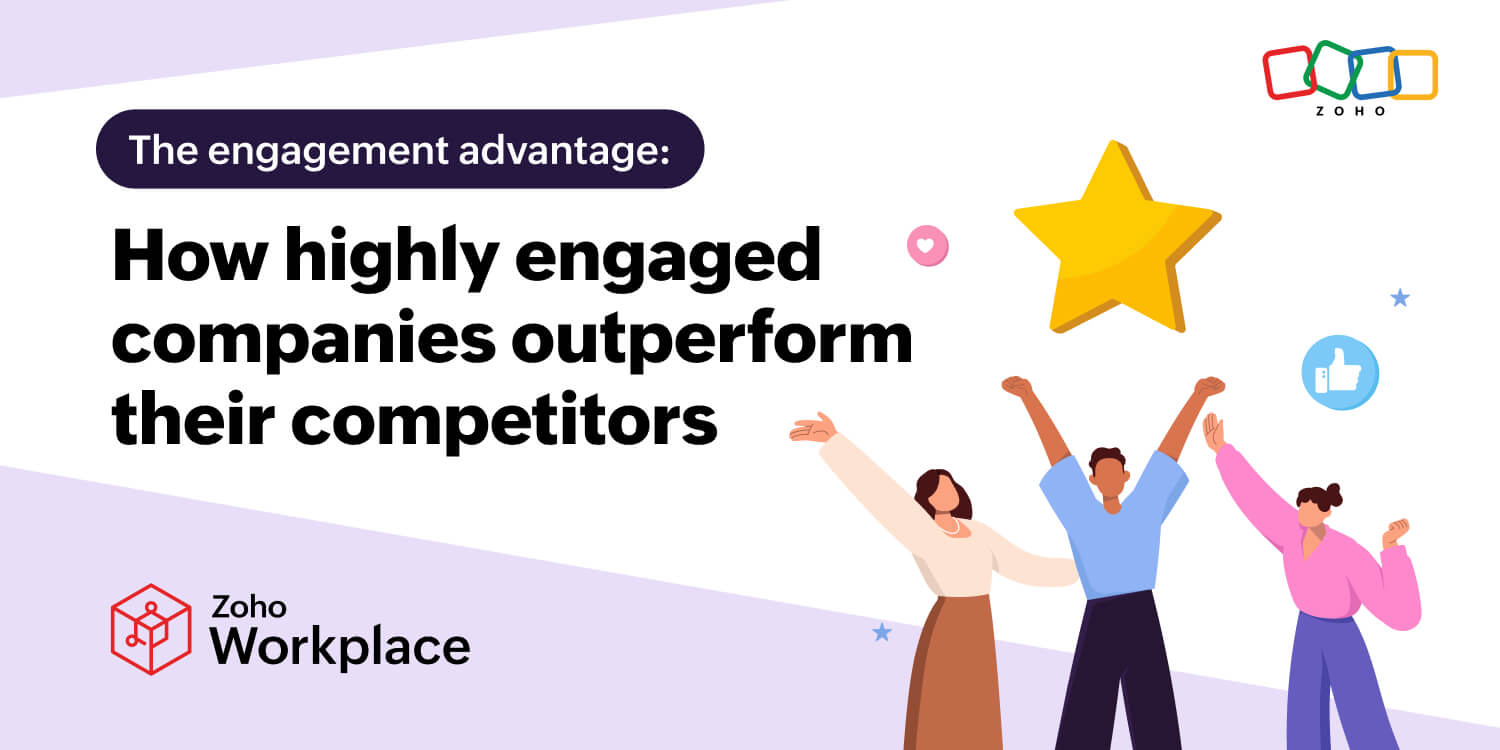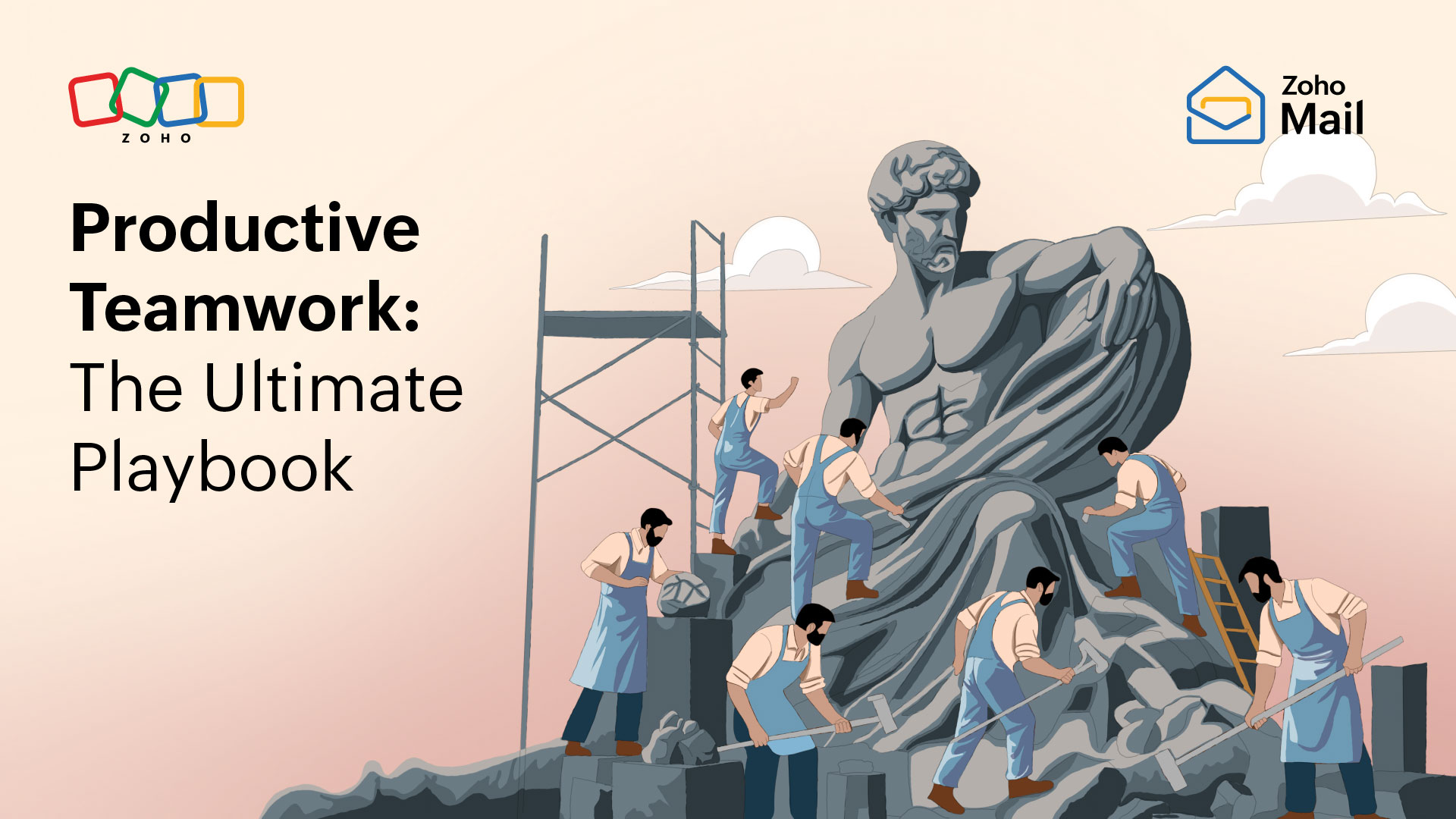- HOME
- All Topics
- Productivity in the workplace
- The engagement advantage: How highly engaged companies outperform their competitors
The engagement advantage: How highly engaged companies outperform their competitors
- Published : April 30, 2025
- Last Updated : April 30, 2025
- 11 Views
- 13 Min Read
What if the secret to unlocking a significant surge in profitability wasn't some complex algorithm or secret handshake, but simply having a workforce that's engaged? It's not just wishful thinking. According to Gallup, companies with highly engaged employees are 23% more profitable. This metric is a clear indicator of the tangible power of a connected and motivated workforce.
Employee engagement isn’t just about keeping smiles on faces—it’s about fueling a workplace that’s resilient, creative, and downright unstoppable. When your team is truly invested, the benefits ripple through every aspect of your business, from increased productivity to enhanced customer satisfaction.
Forget the inspirational posters and vague proclamations. This article digs into actionable insights, not just abstract concepts, on how cultivating genuine employee engagement can actually improve how your organization performs.

Decoding employee engagement
What does employee engagement mean?
We hear the term "employee engagement" a lot, but what does it truly mean? It's more than just a buzzword or a fleeting trend. It's the emotional commitment employees make to their organization and the fulfillment of its goals. It's about feeling a genuine connection, not just showing up for a paycheck.
Think of it this way. A truly engaged employee isn't just satisfied with their job; they're passionate about it. They don't just perform their tasks; they're invested in the outcome. They understand how their work contributes to the bigger picture and feel a sense of purpose in what they do. This passion stems from a deep alignment with the company's values and mission.
So, what isn't employee engagement?
It's crucial to distinguish engagement from related, but distinct, concepts:
- Job satisfaction: While a satisfied employee might be content with their salary and benefits, they may not be deeply invested in the company's success. Satisfaction is often passive; engagement is active. An employee can be satisfied but still be looking for other opportunities.
- Happiness: While a positive work environment contributes to engagement, happiness alone doesn't create it. An employee might enjoy the free snacks and the ergonomic chair, but still lack a strong emotional commitment to the company's goals or feel a sense of purpose in their work. Happiness is a feeling; engagement is a state of being and a driver of performance.
Engaged employees embody three core characteristics:
- Emotional commitment: Employees genuinely care about the organization's success and feel a sense of belonging.
- Passion for the job: Employees are enthusiastic about their work, taking initiative, and going the extra mile.
- Alignment with company values: Employees understand and believe in the organization's mission, ethics, and overall direction.
When these three elements converge, you have a truly engaged workforce—one that is more productive, innovative, loyal, and, ultimately, drives significant positive outcomes for your organization. Understanding this distinction is the first step towards cultivating a workplace where engagement thrives.
The case for fostering employee engagement
We know that engaged employees are emotionally invested and passionate about their work. But does this "feel-good" factor actually impact the bottom line? The answer is a resounding yes.
Cultivating a highly engaged workforce isn't just good for morale. A really engaged crew actually kicks your profits and productivity into high gear, which makes for happy customers. It's surprisingly strategic, that whole "liking your job" thing.
Engagement drives profitability
Picture this: Your team isn’t just checking boxes on their to-do list—they’re out there hunting for ways to work smarter, spark fresh ideas, and push the company forward. The impact of employee engagement on profitability is significant:
- Increased revenue: Engaged employees are more invested in the company's success, leading to higher-quality work and a stronger drive to achieve business goals. They're more likely to do what they can to contribute directly to revenue generation.
- Reduced costs: High engagement directly combats costly issues like absenteeism and employee turnover. Engaged employees are more likely to be present, committed, and less inclined to seek employment elsewhere, saving the significant expenses associated with recruitment, hiring, and training new staff.
- Higher profit margins: It turns out that when people aren't spending half their day looking for opportunities to jump ship, the company functions better. And when the company functions better, the money-making part tends to follow.
Engagement boosts output
An engaged workforce isn't just happier; it's a more productive one. When your team actually understands why they're doing what they're doing and feels like they're part of something bigger, their efficiency doesn't just improve—it practically develops wings.
- Increased efficiency: Engaged employees are more focused, organized, and committed to their tasks. They're less likely to be distracted and more driven to complete their work effectively and efficiently.
- Higher quality of work: Passionate and invested employees take greater pride in their work, leading to fewer errors, higher standards, and an overall improvement in the quality of goods and services.
- Innovation and problem-solving: Engaged employees are more likely to contribute ideas, identify areas for improvement, and proactively solve problems. Their emotional investment fosters a sense of ownership and a desire to make things better.
Engagement leads to delighted customers
How happy your employees are doesn't just create internal office drama. It spills out and directly affects whether your customers think you're amazing or you simply exist. Happy team, happy customers—it's a surprisingly direct link.
- Improved customer interactions: Engaged employees are more enthusiastic, attentive, and empathetic in their interactions with customers. They're more likely to put in the extra effort to understand and meet customer needs, leading to positive experiences.
- Increased customer loyalty: When customers consistently interact with engaged and helpful employees, they develop a stronger sense of trust and loyalty towards the brand. Positive experiences are like the superglue for repeat business and long-term customer relationships.
- Positive brand advocacy: Engaged employees often act as brand advocates, both internally and externally. An employee who is committed to the company is more persuasive than a used car salesman with a winning smile. They can magically turn casual conversations into "You HAVE to check out this company!" moments.
Common traits of highly engaged companies
What sets companies apart where employees thrive, innovate, and consistently deliver exceptional results? The answer often lies in a deeply ingrained culture of employee engagement.
While each may have its own playbook, highly engaged companies consistently nail the fundamentals that foster a connected, motivated, and high-performing workforce. Let's explore these essential elements a little further.
A clear purpose and vision
Imagine navigating a ship without a map. That's how employees feel without a clear understanding of the company's "why" and where it's headed. Highly engaged companies articulate a compelling purpose that resonates with their employees, making them feel like they're part of something bigger than just their daily tasks.
When employees understand the impact of their work and the overall mission, their commitment deepens significantly.
Strong leadership and transparent communication
Engagement starts at the top. Effective leaders in highly engaged companies are more than just managers; they're inspiring figures who lead by example, cultivate trust, and genuinely care about their employees' well-being and development. Crucially, they prioritize open and transparent communication.
Regular updates on company performance, strategic decisions, and even challenges build trust and make employees feel informed and valued.
Genuine recognition and appreciation
Feeling valued is a fundamental human need, and it's a cornerstone of employee engagement. Highly engaged companies cultivate a culture of recognition where contributions, both big and small, are acknowledged and appreciated.
This goes beyond just monetary rewards; it includes sincere verbal praise, opportunities for public acknowledgment, and initiatives that celebrate achievements.
Meaningful opportunities for learning and growth
Stagnation breeds disengagement. Highly engaged companies understand that investing in their employees' growth is an investment in their own future. They provide ample opportunities for skill development, training programs, mentorship, and career advancement.
Offering pathways for learning and progress not only equips employees with the tools they need to succeed but also demonstrates a commitment to their long-term development, fostering a sense of value and ambition.
Strong feedback loops
Feeling heard is paramount to employee engagement. Highly engaged companies actively solicit and value employee feedback through various channels, such as regular surveys, one-on-one meetings, and open forums. More importantly, they act on this feedback, demonstrating that employee opinions matter and contribute to shaping the company's direction.
When employees feel their voice is heard and can influence positive change, their sense of ownership and commitment strengthen.
Autonomy and flexibility
Being treated like a responsible and capable professional is a significant driver of engagement. Highly engaged companies empower their employees with a degree of autonomy over their work and, where possible, offer flexibility in how and when they work.
Give your team a little trust, plus a little freedom, and suddenly they're not just clocking in. They're more motivated, have good ideas, and feel a strong urge to make sure things turn out great.
How employee engagement creates a competitive advantage
We've explored what employee engagement is and why it matters to the bottom line. Now, let's delve deeper into how a truly engaged workforce doesn't just improve internal metrics; it actively creates a significant and sustainable competitive advantage in today's dynamic marketplace.
Competitive edge #1: Agility
The business landscape is constantly shifting. New technologies emerge, consumer preferences evolve, and unexpected disruptions can appear overnight. In this environment, agility—the ability to adapt quickly and effectively to change—is paramount. Engaged employees are a crucial driver of this organizational agility.
Companies with highly engaged employees are significantly more agile. They can pivot faster in response to market demands, capitalize on emerging opportunities, and weather unexpected storms with greater resilience—a distinct advantage over less-engaged competitors.
Competitive edge #2: A powerful reputation
In today's transparent world, your brand reputation is inextricably linked to how your employees feel about working for you. Highly engaged employees become your most authentic and powerful brand advocates.
- Positive word-of-mouth: Employees who are passionate about their jobs naturally speak positively about their company to friends, family, and their networks. This organic endorsement carries far more weight than traditional marketing efforts.
- Enhanced public image: A reputation for treating employees well translates into a positive public image. Customers are increasingly drawn to companies that prioritize their workforce, fostering trust and loyalty.
- Attracting top talent: A strong employer brand, fueled by engaged employees, makes your company a magnet for top talent. In a competitive hiring market, this gives you access to the best skills and minds.
Competitive edge #3: The engagement-loyalty link
The experience your customers have is a direct reflection of your employees' engagement levels. Engaged employees will provide exceptional service and foster stronger customer loyalty.
In a customer-centric world, exceptional service is a major differentiator. Companies with highly engaged employees consistently deliver superior customer experiences, leading to increased customer satisfaction, loyalty, and ultimately, a greater market share.
Measuring employee engagement the right way
You know that a highly engaged workforce is a powerful asset. But how do you tell who's genuinely invested and who's just really good at looking busy? And, more importantly, how do you nudge things in the right direction? Measuring engagement effectively requires a multi-faceted approach that goes beyond simple assumptions.
Here are four key methods companies use to gain valuable insights into their employees' emotional commitment.
1. Employee engagement surveys
Surveys are a cornerstone of engagement measurement, providing a broad snapshot of employee sentiment. However, the frequency and type of survey matter.
Annual engagement surveys: These comprehensive surveys, conducted once a year, offer a deep dive into various aspects of the employee experience. They provide valuable benchmark data and identify overarching trends. Think of them as an annual health check for your organization's engagement levels.
Pulse surveys: Shorter, more frequent surveys (e.g., monthly or quarterly) focus on specific themes or recent events. Pulse surveys allow you to track engagement in near real time, identify emerging issues quickly, and gauge the impact of implemented changes. They're like regular temperature checks, helping you stay agile and responsive.
Key considerations
- Ensure that employees feel safe to provide honest feedback without fear of repercussions.
- Focus on specific behaviors, experiences, and attitudes related to engagement drivers.
- Share key findings with employees and, more importantly, outline the actions being taken based on their feedback.
2. 1:1s and check-ins
Forget spreadsheets for a second. Both formal meetings and those "how was your weekend?" chats between managers and their team members offer invaluable qualitative data on employee engagement.
- Regular 1:1 meetings: Set aside time for managers to talk one-on-one with employees. These chats can cover well-being, challenges, career growth, and how they feel about their job and the company. These personal conversations can reveal issues that surveys may not catch.
- Informal check-ins: Brief, regular touchpoints allow managers to gauge employee morale and identify any immediate concerns. These can be as simple as asking, "How are you feeling about things this week?"
Key considerations
- Equip managers with the skills to conduct effective and empathetic conversations.
- Encourage managers to listen to employee concerns and perspectives.
- Ensure that issues raised during these conversations are addressed appropriately.
3. Anonymous feedback tools
Providing channels for anonymous feedback empowers employees who might be hesitant to voice concerns directly.
- Suggestion boxes (physical or digital): Allow employees to submit ideas and feedback without revealing their identity.
- Anonymous Q&A platforms: Facilitate open discussions where employees can ask questions and raise concerns anonymously.
- Third-party feedback platforms: Some companies use external platforms that guarantee anonymity for more sensitive feedback.
Key considerations
- Promote awareness and trust: Clearly communicate the purpose of these tools and assure employees of their anonymity.
- Monitor and respond: Regularly review the feedback and provide responses or take action where appropriate to show that the input is valued.
4. Engagement KPIs to watch
While qualitative data provides valuable context, key performance indicators (KPIs) can help you track engagement trends and measure the impact of your initiatives over time. Some crucial engagement KPIs to monitor include:
- Employee net promoter score (eNPS): The likelihood of employees recommending your company as a good place to work.
- Retention rate: The percentage of employees who stay with the company for a specific amount of time—often measured in years or even decades. High retention rates often indicate higher engagement.
- Turnover rate: The percentage of employees who leave the company for any reason. A high turnover rate can be a symptom of disengagement.
- Absenteeism rate: Frequent absences can signal a lack of motivation or engagement.
- Productivity levels: While not a direct measure of engagement, sustained high productivity can be an outcome of a motivated and engaged workforce.
- Participation rates in engagement initiatives: Tracking involvement in voluntary programs like training, feedback sessions, and employee resource groups can indicate engagement levels.
- Quality of work: Engaged employees tend to produce higher-quality work with fewer errors.
- Customer satisfaction scores: As discussed earlier, engaged employees often lead to higher customer satisfaction.
Key considerations
- Track consistently over time: This allows you to identify trends and measure the impact of your efforts.
- Benchmark against industry standards: Understand how your engagement KPIs compare to those of your competitors.
- Analyze in conjunction with qualitative data: KPIs provide numbers, but qualitative feedback offers the "why" behind the trends.
There's no one-size-fits-all approach to measuring engagement. The most effective strategy involves a combination of these methods. By gathering clues from the casual chats and fancy charts, you gain a holistic understanding of your employees' emotional commitment. You can finally use that knowledge to make things better and yield better results.
Quick wins for boosting employee engagement
1. Celebrate wins regularly (big and small)
It's easy to get caught up in the daily grind, but acknowledging achievements, both significant milestones and everyday successes, can provide a powerful boost to morale and engagement.
- How to do it: Dedicate a few minutes in team meetings to highlight accomplishments. Send company-wide emails celebrating project completions or positive customer feedback. Create a "wins" channel on your internal communication platform. Even a simple "great job!" can go a long way.
- Why it works: Regular celebration reinforces positive behaviors, makes employees feel valued for their contributions, and fosters a sense of collective achievement.
2. Create internal communities or employee resource groups (ERGs)
Connecting employees with shared interests, backgrounds, or goals can build stronger bonds, foster a sense of belonging, and create a more inclusive workplace.
- How to do it: Support the formation of employee-led groups focused on areas like diversity and inclusion, hobbies, professional development, or shared identities. Provide them with resources and a platform to connect, share, and organize activities.
- Why it works: ERGs provide a sense of community, allow employees to connect on a deeper level beyond their immediate teams, and empower them to contribute to the company culture in meaningful ways.
3. Offer flexible work setups where possible
In today's world, flexibility is increasingly valued by employees. Offering options for remote work, flexible hours, or compressed workweeks (where feasible for the role) can significantly improve work-life balance and autonomy.
- How to do it: Explore roles that can accommodate remote or hybrid work arrangements. Implement core working hours with flexible start and end times. Discuss compressed workweek options with teams. Clearly communicate available flexibility policies.
- Why it works: Flexibility demonstrates trust in employees' ability to manage their work and lives effectively. It reduces stress, improves work-life integration, and empowers employees, leading to increased job satisfaction and engagement.
4. Encourage peer-to-peer recognition
While manager recognition is important, praise and appreciation from colleagues can be particularly impactful and foster a more positive team dynamic.
- How to do it: Implement a simple peer-to-peer recognition platform or encourage informal shoutouts in team meetings or communication channels. Provide opportunities for employees to nominate each other for their contributions or positive attitudes.
- Why it works: Peer recognition fosters a culture of appreciation and collaboration. It makes employees feel seen and valued by their colleagues, strengthening team bonds and reinforcing positive behaviors across the organization.
Common mistakes to avoid in employee engagement
Employee engagement isn’t about quick fixes—it’s about listening, adapting, and investing in what really matters to your team. Skip these mistakes, and you’ll build a workplace where people actually want to stay.
1. One-size-fits-all engagement strategies
Not every employee is motivated by the same things. A junior developer might crave learning opportunities, while a sales rep may thrive on recognition. Personalization is key—avoid generic approaches and tailor engagement efforts to different roles, personalities, and career stages.
2. Ignoring feedback
Asking for employee feedback is great, but ignoring it is worse than not asking at all. If surveys or check-ins reveal concerns but nothing changes, employees will disengage. Always close the loop: acknowledge input, share action plans, and follow through.
3. Focusing only on perks instead of culture
Free snacks and ping-pong tables are nice, but they won’t fix a toxic culture. True engagement comes from trust, purpose, and strong leadership. Prioritize meaningful work, open communication, and growth opportunities over superficial benefits.
4. Measuring without acting on results
Tracking engagement metrics is useless if you don’t do something with the data. If survey scores are low in "career growth," launch mentorship programs. If "work-life balance" is a pain point, revisit those policies to see what you can change. If you put the effort into gaining these insights but you don't take action on them, your efforts will be wasted.
Wrapping up
As leadership guru Simon Sinek wisely stated, "People don't buy what you do; they buy why you do it. And what you do simply proves what you believe." Your employees are no different. When they connect with your "why" and believe in your mission, their engagement—and your business success—will naturally follow.
Companies that consistently outperform their peers haven't stumbled upon some secret formula. Instead, they've intentionally cultivated a culture where employees feel valued, heard, and empowered to contribute their best. They understand that an engaged workforce is:
- More resilient in the face of challenges.
- More innovative in developing solutions.
- More dedicated to achieving organizational success.
- More likely to stay, reducing costly turnover.
The call to action is clear: Invest in your people. Invest in employee engagement. Invest in your future. Start today, stay consistent, and watch your organization flourish.
 Prashanth
PrashanthPrashanth is a Senior Product Marketer in the Zoho Workplace team who focuses more on Workplace productivity and how teams can work better. He loves bringing a creative element to his work. He enjoys traveling, writing, reading, and playing badminton.


